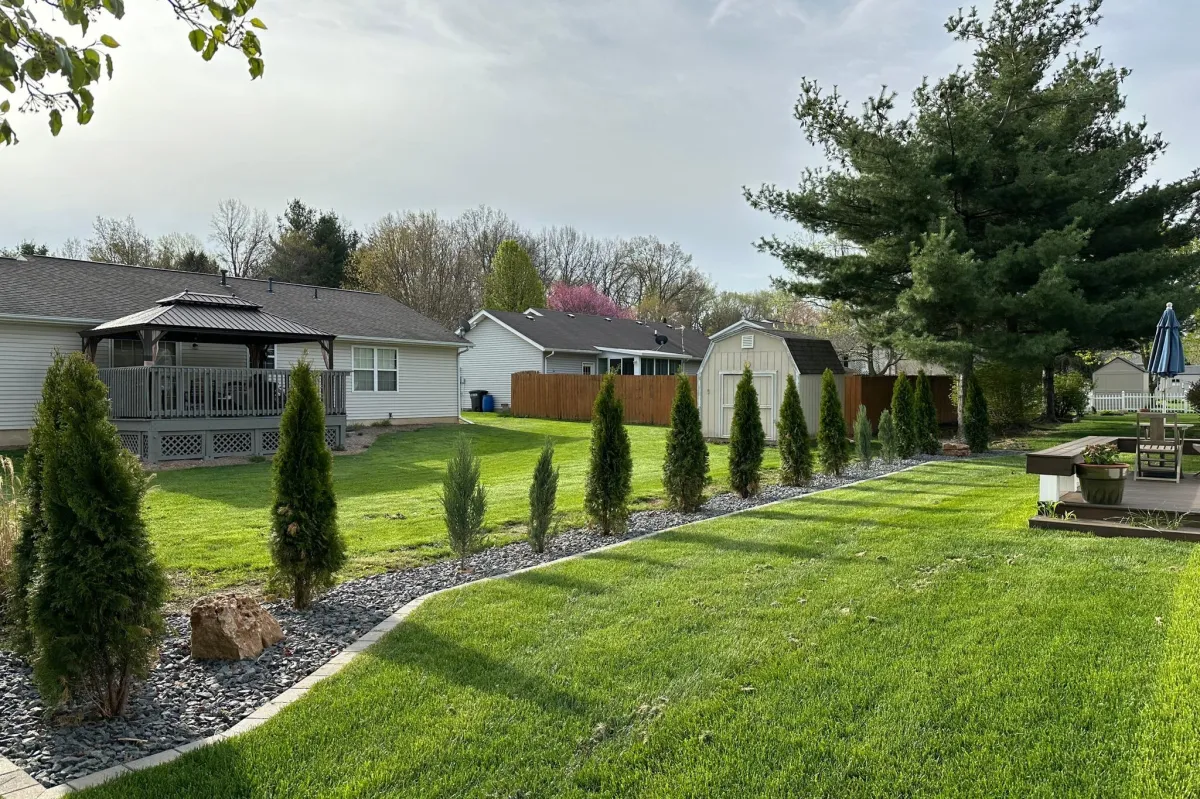Blogs

What Is The Best Time Of Year For Landscaping?
The best time of year for landscaping is typically during the spring or fall seasons, when the weather is mild and conducive to planting and establishing new vegetation. When it comes to transforming your outdoor space, timing is crucial. Choosing the right season for your landscaping project can make a significant difference in its success and longevity.
At Arrow Valley Landscaping, we understand the importance of optimal timing to ensure your landscape thrives for years to come.
Key Takeaways:
Fall, the Ideal Season: Late summer through early fall is optimal for landscaping projects.
Establishing Strong Roots: Fall planting allows plants to develop robust root systems before winter.
Milder Weather Conditions: Cooler temperatures and mild humidity reduce stress on newly planted vegetation.
Plant Variety Availability: Less competition for popular plant varieties in the fall compared to spring.
Mature Landscapes by Spring: Projects completed in fall have more time to grow and mature by the following spring.
Spring vs. Fall: When Should You Landscaping Your Yard?
When deciding between spring and fall for your landscaping projects, understanding the advantages of each season is crucial. Here’s a breakdown to help you choose the best time to transform your yard:
Spring Landscaping
Spring is synonymous with new beginnings, making it an enticing time to revitalize your yard. Here are the benefits:
Optimal Planting Conditions: Warmer temperatures and increased daylight hours create ideal conditions for planting annuals, perennials, and vegetables.
Vibrant Growth: Plants emerge from dormancy in spring, showcasing vibrant colors and rapid growth, enhancing your landscape quickly.
Seasonal Blooms: Enjoy a burst of spring blooms, from tulips to cherry blossoms, adding natural beauty and fragrance to your yard.
Early Maintenance: Addressing winter damage and preparing the soil early sets the stage for a thriving landscape throughout the year.
Fall Landscaping
Fall offers unique advantages that make it a preferred season for many landscapers:
Establishing Roots: Cooler temperatures allow plants to establish strong root systems before winter, promoting healthier growth in the following seasons.
Less Water Stress: Mild weather and reduced evaporation mean less watering stress on newly planted vegetation compared to summer.
Plant Availability: Nurseries often have a wide selection of plants in fall, with less demand compared to spring, providing more choices for your landscape design.
Prepared for Spring: Landscaping in fall gives plants time to acclimate and be well-established by the time spring arrives, resulting in more robust growth.
Choosing the Right Season
The decision between spring and fall ultimately depends on your goals and local climate. Spring is ideal for immediate color and growth, while fall sets up long-term success with healthier plants and less maintenance during the planting phase. Consider consulting with Arrow Valley Landscaping to tailor your project timeline to maximize the benefits of each season.
Choosing Plants for Each Season: A Guide to Seasonal Landscaping
Choosing the right plants for each season is key to maintaining a vibrant and thriving landscape year-round. Here’s a comprehensive guide to help you select plants that flourish in different seasons:
Spring Plants
Spring is a time of renewal and blooming beauty in the garden. Choose plants that thrive in cooler temperatures and can withstand occasional spring showers:
Tulips and Daffodils: These early bloomers bring vibrant colors to your garden beds and containers.
Forsythia: Known for its bright yellow flowers, forsythia adds a splash of color to early spring landscapes.
Lilacs: Fragrant and beautiful, lilacs are a classic choice for spring gardens, attracting pollinators like butterflies.
Pansies: These cheerful flowers come in a variety of colors and are perfect for adding pops of color to borders and pots.
Summer Plants
Summer brings warmth and longer days, ideal for plants that thrive in heat and sun. Choose plants that can handle hot temperatures and occasional drought:
Sunflowers: These tall, cheerful flowers brighten any garden with their sunny faces and provide seeds for birds in the fall.
Hydrangeas: Known for their large, showy blooms, hydrangeas are perfect for adding a touch of elegance to your landscape.
Lavender: Fragrant and drought-tolerant, lavender thrives in sunny spots and attracts pollinators like bees and butterflies.
Daylilies: With their diverse colors and easy care, daylilies are a popular choice for summer gardens, blooming from early to late summer.
Fall Plants
Fall is a season of rich colors and cooler temperatures, ideal for plants that can withstand frost and add warmth to your landscape:
Mums: Chrysanthemums, or mums, come in various colors and are a staple of fall gardens, providing vibrant blooms well into autumn.
Ornamental Grasses: These add texture and movement to fall landscapes with their graceful plumes and golden hues.
Sedum: Also known as stonecrop, sedum offers succulent foliage and late-season blooms that attract butterflies.
Asters: These daisy-like flowers come in shades of purple, pink, and white, providing a burst of color in fall gardens.
Winter Plants
Winter landscapes can still be beautiful with plants that add structure, color, and interest even in cold weather:
Evergreens: From pine trees to boxwoods, evergreens provide year-round interest and serve as a backdrop for winter landscapes.
Winterberry: Known for its bright red berries, winterberry adds color to winter gardens and attracts birds.
Hellebores: Also known as Lenten roses, hellebores bloom in late winter and early spring, offering delicate flowers in shades of white, pink, and purple.
Camellias: With their glossy evergreen leaves and early winter blooms, camellias are a classic choice for winter gardens.
By selecting plants that thrive in each season, you can create a dynamic and visually appealing landscape that changes with the seasons.
Weather Considerations: How Climate Affects Your Landscape Timing
Understanding how climate influences your landscaping timing is crucial for creating a sustainable and thriving outdoor space. Here’s how different weather considerations impact your landscape projects:
Temperature Extremes
Heat Waves: During hot spells, newly planted vegetation can suffer from heat stress and require more frequent watering to survive.
Cold Snaps: Sudden drops in temperature, especially below freezing, can damage tender plants and require protective measures like mulching or covering.
Precipitation Patterns
Rainfall: Adequate rainfall reduces the need for supplemental watering but can lead to soil erosion if not managed properly.
Drought: Periods of drought necessitate water-efficient landscaping and drought-tolerant plants to conserve water and maintain landscape health.
Seasonal Variations
Spring: Rapid temperature changes and fluctuating weather patterns require careful monitoring of plant health and soil conditions.
Summer: High temperatures and intense sunlight require shade-loving plants or strategic placement of landscaping features to minimize heat stress.
Fall: Mild temperatures and moderate rainfall create optimal conditions for planting and establishing new vegetation.
Regional Considerations
Humidity Levels: High humidity can promote fungal diseases in plants, requiring proper air circulation and plant spacing to prevent issues.
Wind Exposure: Windy conditions can dry out soil and damage delicate plants, necessitating windbreaks or sheltered planting areas.
Microclimates
Urban Heat Islands: Urban areas tend to be warmer than surrounding rural areas due to heat retention in buildings and pavement, influencing plant selection and maintenance requirements.
Shade vs. Sun: Variations in sunlight exposure within your landscape create microclimates that affect plant growth and health, requiring tailored planting strategies.
Soil Conditions
Soil Type: Different soil types, such as clay or sandy soil, influence drainage, nutrient availability, and plant selection for optimal growth.
pH Levels: Soil pH affects nutrient uptake by plants, requiring adjustments through soil amendments or plant selection for pH-sensitive species.
Understanding these weather considerations allows you to plan and execute landscaping projects effectively, ensuring your outdoor space thrives year-round.
Planning Ahead: Seasonal Landscape Design for Year-Round Enjoyment
Planning ahead for seasonal landscape design is essential for maximizing enjoyment and functionality throughout the year. Here’s how you can create a landscape that evolves with the seasons:
Assessing Your Space
Site Analysis: Evaluate sunlight exposure, soil conditions, and existing features to determine the best layout for your landscape design.
Functional Zones: Designate areas for entertaining, gardening, relaxation, and play to optimize space usage and meet your family's needs.
Seasonal Themes and Plant Selection
Spring: Incorporate early bloomers like tulips and daffodils for vibrant color, complemented by budding trees and shrubs.
Summer: Choose heat-tolerant plants such as hydrangeas and daylilies, paired with outdoor seating and shade structures for comfort.
Fall: Integrate warm hues with mums and ornamental grasses, enhanced by seasonal accents like pumpkins and decorative gourds.
Winter: Utilize evergreens and hellebores to maintain greenery, accented by berries and winter-flowering plants for visual interest.
Hardscape Features
Paths and Walkways: Create inviting pathways using materials that complement your home's architecture and enhance accessibility.
Patios and Decks: Design outdoor living spaces with seating, dining areas, and fire pits to extend usability into cooler months.
Sustainable Practices
Water Efficiency: Install drip irrigation and rainwater harvesting systems to conserve water and maintain plant health during dry spells.
Native Plants: Choose native species adapted to local climate conditions for minimal maintenance and enhanced biodiversity.
Year-Round Maintenance
Pruning and Trimming: Schedule regular maintenance to keep plants healthy, promote growth, and maintain aesthetic appeal.
Seasonal Clean-Up: Clear debris, mulch beds, and prepare plants for seasonal changes to minimize stress and ensure longevity.
By planning ahead and integrating seasonal elements into your landscape design, you can create a dynamic outdoor space that evolves with the changing seasons.
FAQs
1. When is the best time to plant trees and shrubs?
Fall is ideal for planting trees and shrubs as it allows them to establish roots before winter. This promotes healthier growth come spring.
2. Can I start a landscaping project in the summer?
Yes, but be mindful of the heat. Watering and choosing heat-tolerant plants are key to successful summer landscaping.
3. What are the benefits of fall landscaping over spring?
Fall offers milder weather, less competition for plant varieties, and more time for plants to establish before winter dormancy.
4. How can I prepare my lawn for winter?
Winterize your lawn by aerating, fertilizing, and overseeding. This helps grass roots grow deeper and prepares it for colder months.
5. What services does Arrow Valley Landscaping offer year-round?
We provide comprehensive landscaping services throughout the year, including design, installation, maintenance, and seasonal preparations.
Optimize Your Landscape Year-Round with Arrow Valley Landscaping
Transform your outdoor space with confidence at Arrow Valley Landscaping. Whether you're planning a project for fall, summer, winter, or spring, our team is here to ensure your vision becomes a reality. Choose the optimal season for your landscaping needs and let us help you create a space you'll love year-round.
Contact us now at Arrow Valley Landscaping to schedule a consultation. Let us bring our expertise and passion for landscaping to your doorstep. Create the landscape of your dreams with Arrow Valley Landscaping.

With years of experience serving Illinois, we’re proud to be the trusted choice for a professional and high quality landscaping.
Service Area
Fayette County
Madison County
Contact Us
Phone:
Email:
Address
© 2024 Arrow Valley Landscape ltd. All Rights Reserved. Privacy Policy. Web Design by Fused Media


